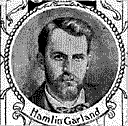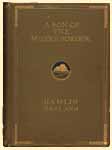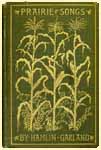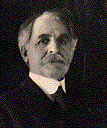

 |
 |
HAMLIN GARLANDfrom Wisconsin Authors and Their Works 1918
|
 |
|
Hamlin Garland was born at West Salem in the beautiful La Crosse valley, September 16, 1860, and lived there until he was eight years old. Twenty-four years ago he purchased the old homestead near West Salem, La Crosse County, and to this he returns each year for a part of the summer. Other states that may share the right to claim Mr. Garland are Iowa, Massachusetts, Illinois, South Dakota, and New York. In Iowa he learned what the rural school, the academy, and the farm could teach him. He graduated from the Cedar Valley Seminary at Osage in 1881. |
 Garland Home |
|
 Zulime & Mary Isabel Garland |
It was in the Boston Public Library, however, where he came under the influence of Moses True Brown of the Boston School of Oratory, Oliver Wendell Holmes, William Dean Howells, Edward Everett Hale, and Edwin Booth, that his literary style was chiefly formed. It was here, strange to say, that he determined to choose his literary subjects from the West that he knew so well. In Illinois he began his work as a teacher and a lecturer. Here he met the girl who was to become his wife--Miss Zulime Taft, sister of the sculptor, Lorado Taft. |
|

|
Mr. Garland knows all phases of country life. He has expressed his observations in description of boys' games, the labor on the farm, the work of the rural school, and the varied activities of the rural community. He knew that the work of the farm in an early day furnished as much opportunity for the display of resistance and the determination to use the last bit of strength to win as do the games of the present. The work of binding the wheat after a reaper became a game requiring honesty as well as skill and rapidity. Perhaps no boy of today shoots a basket, makes a touchdown, or hits out a home run with more pride than did the youth of this pioneer life retire from the harvest field at noon or night with the consciousness that he had bound all his "tricks" without being caught once by the machine as it made its successive rounds of the field. |
 |
|
Hamlin Garland knew the joys of these contests on the pioneer farm, and he also knew the sordid side of the narrow and cramped life of the early settler. He describes both with equal vividness and sympathy. Wisconsin owes him much for the work he has done in preserving pictures of her early pioneer life. His hero and heroine are those ancestors who travelled forth into the new regions in covered wagons, and by the use of axe and plow conquered a seemingly unconquerable forest or a stubborn prairie sod. In his book of short stories, "Main Travelled Roads," he makes the dedication of it to his heroic parents in these words: |
 Father's return from the war |
|
 Garland's mother |
"To my father and mother, whose half-century pilgrimage on the main travelled road of life has brought them only toil and deprivation, this book of stories is dedicated by a son to whom every day brings a deepening sense of his parents' silent heroism." |
 Hamlin Garland |
|
Mr. Garland began his career as an author with the publication of his poem, "Lost in a Norther," in Harper's Weekly. He has been a contributor to the Century, the Youth's Companion, the Arena, and many other magazines. His first book was published in 1890. He is especially fond of outdoor sports such as swimming, skating, and riding the trail on plains and mountains. He was the founder and is still the president of the Cliff Dwellers Club in Chicago. His present home is in New York City. |